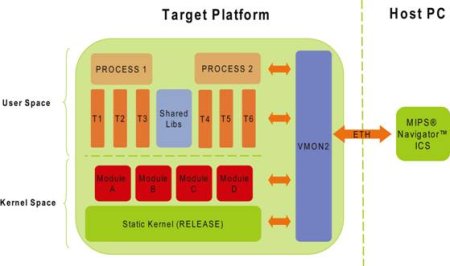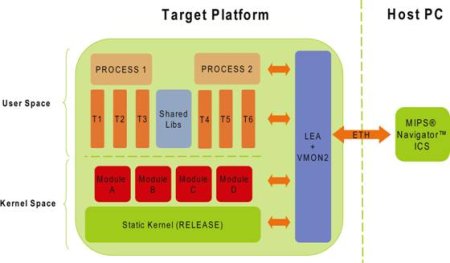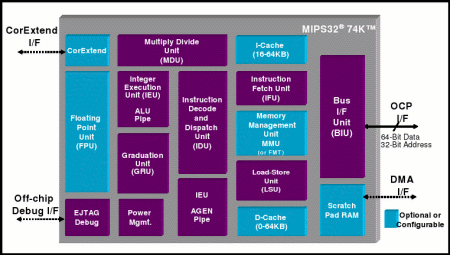Linux development suite debuts for MIPS
Sep 15, 2008 — by Eric Brown — from the LinuxDevices Archive — 19 views Semiconductor design firm MIPS Technologies has integrated homegrown and third-party development tools into a Linux toolsuite for embedded developers. Incorporating components from CodeSourcery and Viosoft, the MIPS Navigator Integrated Component Suite (ICS) aims to streamline coding, debugging, and analysis of… MIPS-based system-on-chips (SoCs), says MIPS.
Semiconductor design firm MIPS Technologies has integrated homegrown and third-party development tools into a Linux toolsuite for embedded developers. Incorporating components from CodeSourcery and Viosoft, the MIPS Navigator Integrated Component Suite (ICS) aims to streamline coding, debugging, and analysis of… MIPS-based system-on-chips (SoCs), says MIPS.
(Click for larger view of a MIPS Navigator ICS debugging screen)
MIPS Navigator ICS combines:
- A MIPS-optimized version of CodeSourcery's Sourcery G++ development environment for C/C++
- Viosoft's MIPS-targeted Arriba Linux Debugger (AlD) and Linux Event Analyzer (LEA) Eclipse plug-ins
- The Hot Spot Analyzer (HSA) utility from MIPS itself
The package of “pre-verified” components is rounded out with a variety of other plug-ins, MIPS executables, and quick-start projects, says MIPS.
Sourcery G++
CodeSourcery's “G++” products are based on the GNU tools, with added testing, refinement, and commercial support. Besides MIPS, the tools are offered for ARM, Coldfire, fido, PowerPC, Stellaris, and IA32 platforms.
G++ for MIPS includes GNU C/C++ compilers, a GNU assembler and linker, runtime libraries, and a source- and assembly-level debugger, says CodeSourcery. There is also support for a Microprocessor Debug Interface (MDI) to connect to MIPS System Navigator Probes and the MIPSsim simulator. The MIPS Navigator ICS integration includes the optional G++ Eclipse integrated development environment (IDE).
CodeSourcery started shipping an updated version of G++ for MIPS in June. The new G++ for MIPS release is said to support “non-position independent code,” for a claimed performance boost under Linux. G++ also covers more MIPS cores than previous versions, adding support for the the MIPS32 24K core, says the company, as well as the superscalar MIPS32 74K core (see diagram farther below).
Viosoft Arriba Linux Debugger (ALD)
Like CodeSourcery, Viosoft has long supported the MIPS platform with its Linux-friendly development tools. Now, MIPS is integrating two of the company's Eclipse debugging plug-ins: the Arriba Linux Developer (ALD) and the Viosoft Linux Event Analyzer (LEA).
MIPS descibes ALD as highly portable, adding that it eliminates the “need to instrument, recompile or use kernel patches.” The tool is said to provide a variety of debugging drivers and applications over a single connection, and to enable the debugging of multiple threads/processes, as well as debugging of shared libraries (see diagram below). It does not pre-empt the kernel, says the company, thereby making it a good fit for multimedia and real-time applications.

Viosoft Arriba Linux Developer (AlD) for MIPS diagram
(Click to enlarge)
LEA is an optional plug-in offering kernel and application-level profiling for MIPS-based devices, says MIPS. The tool is said to capture all Linux events occurring on the target, and to present a graphic display of events over time. As with ALD, the plug-in is said to eliminate the need to recompile the kernel or instrument the application. LEA is said to complement MIPS's own new Hot Spot Analyzer (HSA) plug-in.
 MIPS FS2 System Navigator EJTAG probe |
MIPS Hot Spot Analyzer (HSA)
MIPS announced and shipped its HSA kernel profiling utility in April. Designed to work with its MIPS FS2 System Navigator EJTAG probes (pictured at right), HSA leverages the “zero overhead” program counter (PC) sampling feature built into MIPS32 core families. HSA enables developers to profile any code running in the kernel segment space of an embedded MIPS-based system, including “bare iron” programs or classic real-time operating system (RTOS) environments, says MIPS. It can also profile loadable modules used in device drivers, and enable software engineers to quickly identify program bottlenecks within the Linux kernel that restrict system performance, says the company. The utility was developed by its First Silicon Solutions (FS2) division.

Viosoft LEA for MIPS diagram
(Click to enlarge)
Wait, there's more
Additional Navigator ICS components are said to include:
- Projects to provide quick start for users
- MIPSsim executables for all current MIPS cores
- Standard plug-ins for control and configuration of targets
- Standard plug-ins for debug and optional plug-ins for RTOS and Linux-aware debug
- Standard plug-ins for analysis and optional plug-ins for advanced analysis
- Support for MIPS System Navigator probes
MIPS claims to be is the world's second largest semiconductor design IP company and the largest analog IP company. MIPS cores are found in a variety of embedded applications, and are particularly popular in set-top boxes (STBs), thanks to SoC offerings from vendors such as Sigma and Broadcom. Lately, MIPS has also been making the scene in Linux-compatible netbooks. Several Chinese-manufactured netbooks have been incorporating MIPS-based SoCs such as the Longsoon-2F chip and the Ingenic Jz4740 Multimedia Application Processor, which powers Bestlink's Alpha 400 mini-notebook and 3K's RazorBook 400-Mini-Notebook.

MIPS 74K pipeline flow
(Click to enlarge)
Stated Jack Browne, VP of marketing, Processor Business Group, MIPS Technologies, “Navigator ICS can be used across the entire system, providing low-level debug to high-level application analysis.”
Availability
MIPS Navigator ICS will be available this quarter, says MIPS. Licensing is on a per-seat basis through node-locked or floating licenses, starting at $1,945 for a single node-locked license with one year of support and maintenance. More information on MIPS Navigator ICS may be found here.
This article was originally published on LinuxDevices.com and has been donated to the open source community by QuinStreet Inc. Please visit LinuxToday.com for up-to-date news and articles about Linux and open source.